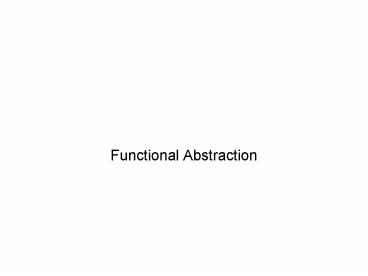Functional Abstraction - PowerPoint PPT Presentation
1 / 26
Title: Functional Abstraction
1
- Functional Abstraction
2
What Happened Yesterday
- Data abstraction / ????
- Rational numbers
- A function to create them
- Functions to manipulate them
- Ways of combining and accessing data
- cons, list, car, cdr, list-ref
3
What Will Happen Today
- Review of abstraction as a useful tool
- Learning about functional abstraction
- Another problem with languages like C, C, and
Java! - A way to create local variables
4
What Is 'Data'?
- Defined by
- Selectors (ways to access)
- Constructors (ways to make)
- Rules that ensure a good representation
- Example
- Xiao Xiao's rational number
- Lists (from yesterday)
5
Some More Ideas
- Abstract properties
- What the data is supposed to do / how it behaves
- Example Lists using cons, car, cdr
- Implementation
- The exact/concrete way that something is built
- Think about the many ways to define exponentiation
6
Abstraction /???? Defined
- Separating the abstract properties
- of data from its implementation
7
Another way to think of abstraction
- A black box
- You know what the inputs and outputs are / how
they behave - The implementation is completely hidden
- Assume that the black box works correctly
8
Black Box Examples
9
Why is abstraction useful?
- Allows for modularity / You can change things
- Makes things easier to generalize
- Things are easier to scale to a large size
- A useful way to control complexity
10
Real World Abstractions
- TV remote
- AC adapter
- Sigma notation
- ? f(x) f(0)...f(n)
- Circuit elements
- resistor, capacitor, current source, etc.
- Thermostat
- Piano keys
11
How To Build An Abstraction
- Assign names to common patterns
- Don't use ( x x x)
- Do use (cube x)
- Think about what you should be given and what you
should give - Remember that only you should need to know how
things actually work
12
Higher Order Procedures
- Procedures that manipulate or change other
procedures - Good way of creating abstractions
- Not truly supported in many languages!
13
Summing Numbers
- The sum of integers from a to b(define
(sum-integers a b) (if (gt a b) 0 (
a (sum-integers ( a 1) b)))) - The sum of the cubes of integers from a to
b(define (sum-cubes a b) (if (gt a b) 0
( (cube a) (sum-cubes ( a 1)
b))))
14
Summing Numbers
- Thanks to Leibniz we know that ?/8 (define
(pi-sum a b) (if (gt a b) 0 ( (/
1.0 ( a ( a 2))) (pi-sum ( a 4) b))))
15
Hints for creating abstraction
- Look for patterns then make an abstraction
- Do you see a pattern?
- (define (pi-sum a b) (if (gt a b) 0
( (/ 1.0 ( a ( a 2))) (pi-sum ( a 4)
b)))) - (define (sum-int a b) (if (gt a b) 0
( a (sum-int (inc a) b)))) - (define (sum-cubes a b) (if (gt a b) 0
( (cube a) (sum-cubes ( a 1) b))))
16
Template for Summing
- Identifying the pattern(define (ltnamegt a b)
(if (gt a b) 0 ( (lttermgt a)
(ltnamegt (ltnextgt a) b)))) - Implementing the pattern(define (sum term a
next b) (if (gt a b) 0 ( (term a)
(sum term (next a) next b))))
17
Summing Using Our Abstraction
- Summing integers(define (identity a) a)(define
(inc a) ( a 1))(define (sum-integers a b)
(sum identity a inc b)) - Summing cubes of integers(define (sum-integers
a b) (sum cube a inc b))
18
Summing Using Our Abstraction
- ? (define (term a) (/ 1.0 ( a ( a
2))))(define (sum-pi a b) ( 8 (sum
term a
(lambda (a) ( a 4)) b)))
19
Remember!
- (define (sum term a next b) (if (gt a b)
0 ( (term a) (sum term (next a)
next b)))) - This abstraction is relies on term and next being
procedures / functions. - Our language must support passing functions
(Scheme does!)
20
Defining Local Variables
- Want to create a function with less fuss
- Defining all of those helper procedures
(identity, inc, dec, etc.) is messy - Is there a better way to do it?
- Let us work with a multi-variable functionf(x,
y) x2(1xy) y(1-x) 3
21
Old Way
- If a (1xy) and b (1-x) thenf(x, y) ax2
by 3 - (define (a x y) ( 1 ( x y)))(define (b x y) (-
1 x))(define (f x y) ( ( (square x) (a x
y)) ( y (b x y)) 3)) - Bad! This requires that things be defined
outside the function when they are only used
inside the function
22
Newer and Better Way
- You can have a define within a define to use
later in your code(define (f x y) (define
(f-helper a b) ( ( (square x) a) ( y b)
3)) (f-helper ( 1 ( x y)) (- 1 x)))
23
Newer and Slightly Better Way
- Instead of having an extra define, use an unnamed
lambda and pass it arguments(define (f x y)
((lambda (a b) ( ( (square x) a) ( y b)
3)) ( 1 ( x y)) (- 1 x)))
24
Special form let
- New way of doing things binds 'a' and 'b' to the
specific values(define (g x y) (let ((a ( 1
( x y))) (b (- 1 x))) ( ( (square
x) a) ( y b) 3)))
25
- The general form of a let expression is(let
((ltvar1gt ltexp1gt) (ltvar2gt ltexp2gt)
(ltvarngt ltexpngt))ltbodygt) - Equal tolet ltvar1gt have the value ltexp1gt and
ltvar2gt have the value ltexp2gt and ltvarngt have
the value ltexpngtin ltbodygt
26
What We Covered
- Abstraction
- Procedural Abstraction
- The special form let































